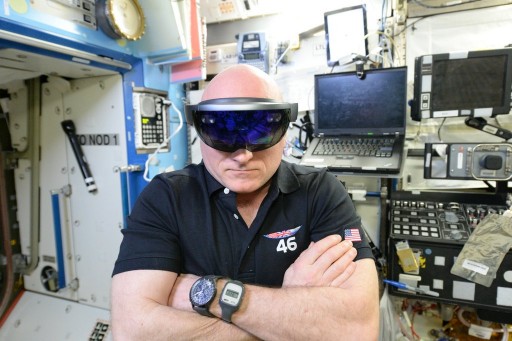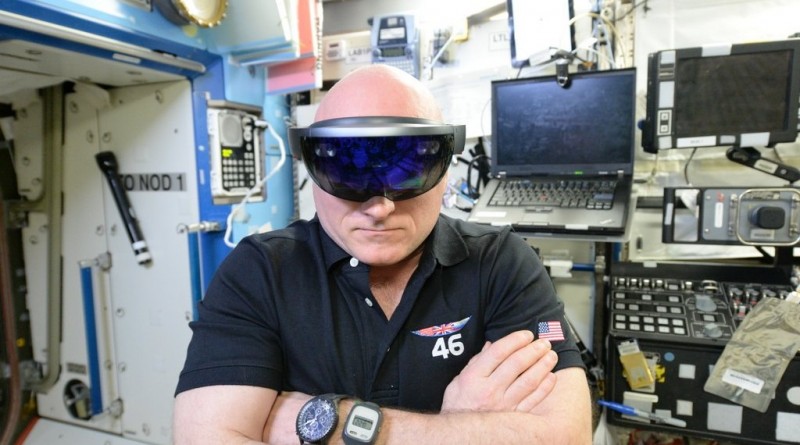ISS Operations Update – February 19, 2016

Experiments:
Sidekick Checkout [In use on ISS, the Sidekick (Microsoft HoloLens) hardware can be operated in Remote Expert Mode in which Skype is used to allow a ground engineer to see that the crew member sees which could ease real-time guidance when completing complex tasks including those for which no prior training on the ground was conducted. Also, ground team members could draw annotations into the crew member’s environment to help complete a task. In Procedure Mode, animated holographic illustrations can be displaced on top of objects a crew member is handling in order to lessen the amount of training future crews will require. This type of application could be of tremendous use in missions to more distant targets when communication delays complicate real-time ground support.]
NeuroMapping Experiment Ops [Spaceflight Effects on Neurocognitive Performance: Extent, Longevity, and Neural Bases (NeuroMapping) examined whether long-duration exposure to microgravity causes changes in the brain, including brain structure and function, motor control, and multi-tasking, as well as measuring how long it takes for the brain and body to recover from those possible changes. The experiment uses MI and FMRI scans before and after spaceflight and computer-based Mental Rotation Tests while on ISS.]
Biological Rhythms 48 Hours [The BLR48 and Circadian Rhythms Study will examine the role of synchronized circadian rhythms and possible maintenance during long-duration spaceflight and addresses the impacts to crew members’ health and wellbeing. Understanding how the dark/light cycle and sleep shifting affects circadian rhythms and with that the performance of the crew members will enable scientists to develop new sleep shifting techniques for crew members in space and shift workers on Earth.]
RADI-N – Collection of 8 detectorsdeployed in the Japanese Experiment Module and handover to Russian crew
Ocular Health – Optical Coherence Tomography, Eye Ultrasounds, Tonometry Measurement [OH is a human physiology study. Its full name is Prospective Observational Study of Ocular Health in ISS Crews. “The Prospective Observational Study of Ocular Health in ISS Crews (Ocular Health) protocol aims to systematically gather physiological data to characterize the Risk of Microgravity-Induced Visual Impairment/Intracranial Pressure on crewmembers assigned to a 6 month ISS increment,” the NASA experiment overview said. It is known that some (not all) astronauts in orbit experience changes in visual acuity (visual clarity) and intraocular pressure as a result of fluid shifts within the body as it is subjected to microgravity. About 20% is astronauts flying to ISS have reported these kinds of changes. Test subjects will undergo pre-flight, flight and post-flight testing of their eyes using a variety of techniques.]
Pilot-T [This experiment puts crew members through complex tasks, such as piloting a space vehicle, at various stages of a long-duration mission to assess crew member performance reliability over long mission durations.]
Matryoshka-R – Dosimeter Readings [Matryoshka-R consists of a number of radiation dosimeters that are set up inside the space station to assess radiation exposure of the crew relative to ISS position in its orbit and shielding provided by the modules.]
Maintenance/Systems:
Nominal Inspections/Servicing Tasks (Morning Inspection, Caution & Warning Panel Check, Sozh System Maintenance) (Russian Crew)
Multi-Purpose Small Payload Rack 2 – Workbench locking mechanism troubleshooting
Microbial Removal Filter (MRF) Purge
IP-1 Airflow Sensor Position & Performance Verification
Other Activities:
Cygnus Departure: See Article
Extravehicular Mobility Unit (EMU) Water Conductivity Test on Suits #3003 and #3010
Crew Departure Preparations
Progress MS Cargo Transfers
Weekly Tagup with Russian Mission Control Team
Soyuz TMA-18M Return Cargo Preparation

